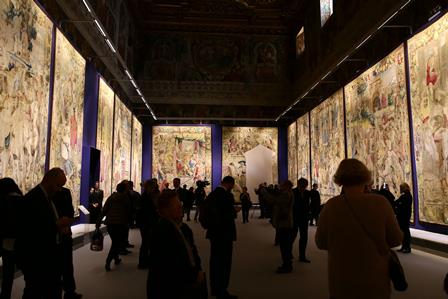
WTI Magazine #55 2015 March, 6
Author : Enrico De Iulis Translation by: John Cabot University
An important exhibition, for its beauty and rareness, will be hosted at the Salone dei Corazzieri in Palazzo del Quirinale until April 12, 2015. The exhibition is based on the entire cycle of tapestries on the story of Joseph narrated in the Old Testament. The tapestries had been commissioned by Duke Cosimo I Medici to three famous artists: Angnolo Bronzino, Pontormo and Francesco Salviati.
The exhibition represents the first inauguration officiated by the new President of the Republic Sergio Mattarella who also plans to reopen most of Palazzo del Quirinale to the public. This event is one of the greatest initiatives regarding History and Art undertaken for EXPO 2015 in Milan. The tapestries of the Quirinale will be moved to the Sala delle Cariatidi of Palazzo Reale in Milan for EXPO.
Joseph's tales in the Old Testament have always been appreciated by the Medici dynasty that recognized in this epic a clear sign of their efficient rule and social justice. The Medici family truly believed that their own administration was supported by moral rectitude and forgiveness, which were necessary and paradigmatic qualities for being considered a good ruler.
Cosimo I became Duke through his marriage to Eleonora da Toledo, daughter of the Spanish viceroy of Naples. Cosimo started the huge restoration project of the Palazzo dei Priori in Piazza della Signoria beginning in 1540 (it was during the restoration of the palace that Leonard's "Battaglia di Anghiari" was lost, probably covered with a fresco of Giorgio Vasari). In 1545, Pontormo and Bronzino, official artists of the Medici court, with Francesco Salviati, were in charge of painting the models for the series of twenty tapestries six meters high, totaling four hundred square meters of figured fabrics.
For their realization,, the models were entrusted to the Flemish masters of tapestry Jan Rost and Nicolas Karcher in a local laboratory that remained active in Florence two hundred years following. The result of this laborious endeavor is now shown in the Salone dei Corazzieri of the Quirinale, where the entire production of tapestries, usually divided between the Quirinale and the Soprintendenza of the Belle Arti of Florence, has now been united for the first time in 150 years.
Viewers enter into a dark room where they find the tapestries illuminated by a skillful use of oblique and frontal lights, which enhance the best features of the work. In this way, the subject, warp and colors of the restored Florentine tapestries are accentuated, contrasting with the Roman tapestries whose color is more uniform and less intense. The light reflects the subtle metallic, gold or platinum colors of the threads. The effect is very interesting: allowing viewers to notice the incredible technique.
If close up one appreciates the admirable technique, from afar one must discern the space represented by the figures, the architecture and the particularities. At first glance the scene seems flattened, but, as the eye adjusts, one can appreciate the contrast and the interpretative subtleties of the artists and tapestry makers. One rarely has the possibility to view an exhibition dedicated exclusively to tapestries; often other types of art overshadow them. Instead, in this occasion the full beauty of these works can be admired.



